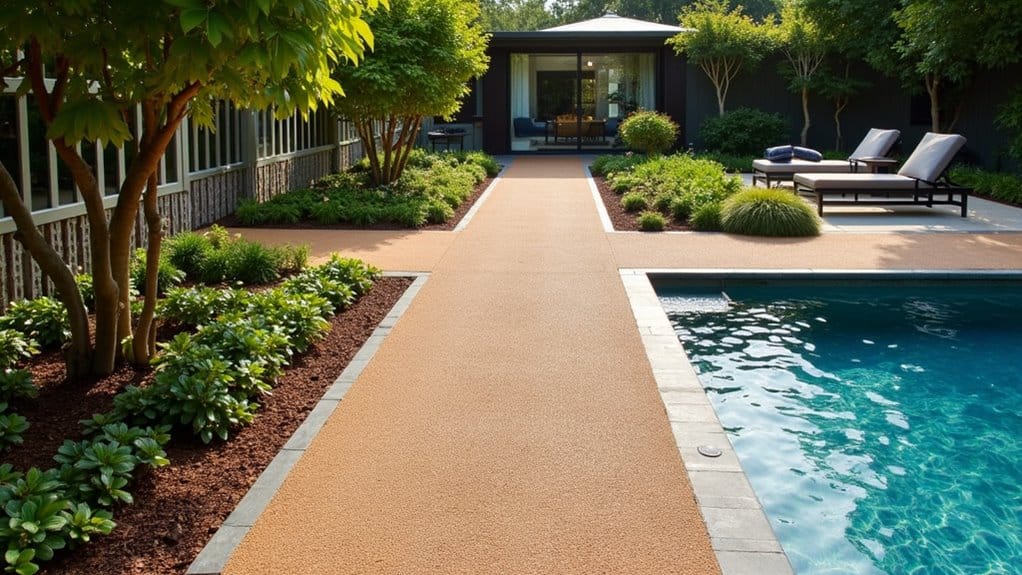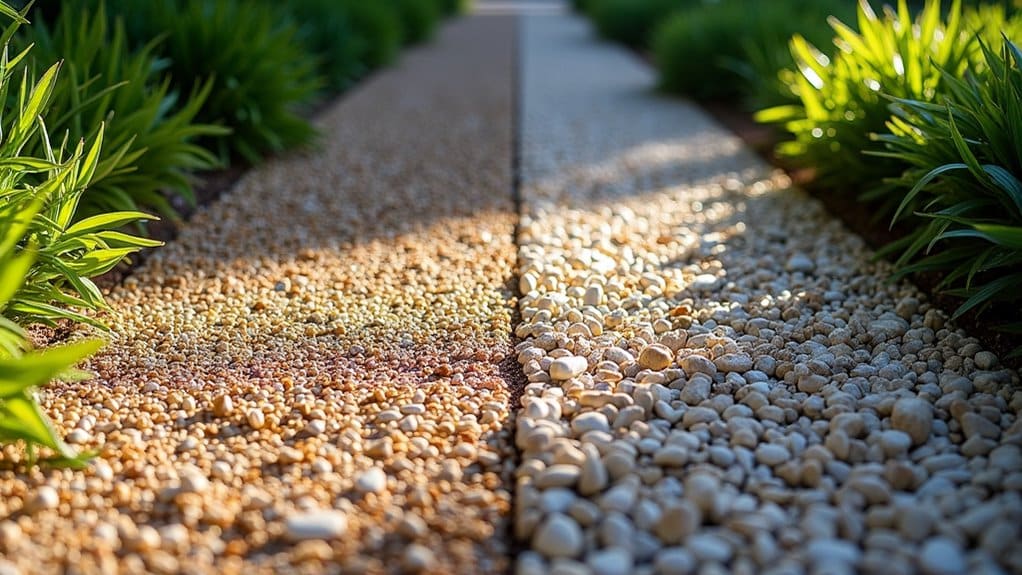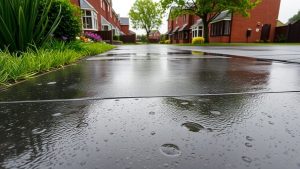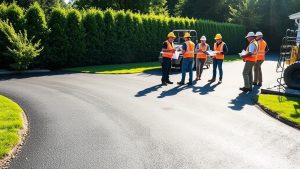For a successful resin bound stone installation, it’s essential to have a stable base that allows for proper drainage. Start with a well-compacted sub-base of 100-250mm, using MOT Type 3 aggregate. Macadam or open textured tarmac are excellent choices as they offer both strength and permeability. Ensure the surface is level, clean, and free of cracks. For tarmac, aim for a minimum thickness of 70mm, while concrete should be at least 100mm thick to provide adequate strength. Regular maintenance will help extend the lifespan of your installation. Want to know how to prepare the base correctly? There’s more important information to ensure your project lasts.
Table of Contents
ToggleKey Takeaways
For a successful resin bound stone installation, a stable sub-base thickness of 100-250mm is crucial, depending on the soil conditions. Suitable materials include MOT Type 3 aggregate, macadam, or open textured tarmac to ensure effective drainage. If you’re using a concrete base, it should be at least 100mm thick with a C35 rating for areas with heavy traffic.
Ensure that each layer is properly compacted and levelled; this prevents movement and supports a robust resin bound surface. Regular maintenance, such as cleaning, will further enhance the durability and lifespan of your installation.
Sub-Base Considerations
When planning your resin bound stone installation, it’s crucial to consider the sub-base, as it significantly affects the durability and performance of the system.
Start with a thorough assessment of the soil; its condition will determine the necessary thickness of your sub-base, typically between 100 and 250mm. If the soil is weak or unstable, you may need to increase the thickness for a solid foundation.
Ensure there’s a proper slope for effective drainage. Non-permeable bases must be designed to channel water runoff efficiently, as the load-bearing capacity of the base is essential for a successful installation.
The sub-base surface should be level to provide a strong platform for the resin bound system. It’s essential to compact your chosen material, ideally well-compacted MOT Type 3, using a plate compactor to prevent movement and sinkage. This material is recommended due to its non-frost susceptibility, which enhances the longevity of the installation.
Check the existing base for any damage and consider installing edging to protect the resin surface from potential boundary removals. Using sharp sand and cement for the edging will help keep the new surface secure.
With these steps, you’ll establish a robust sub-base that optimises the performance of your resin bound installation.
Base Material Options

Selecting the right base material for your resin bound stone installation is crucial for optimal performance and durability. Macadam is a top choice due to its robust nature and stability. It allows for effective drainage, meeting SuDS requirements, and can support various loads. Its resilience against traffic helps reduce settlement issues, making it ideal for permeable installations. Open textured tarmac (AC14) is another solid option, offering a strong, permeable base that complies with SuDS regulations. For lighter load-bearing needs, MOT Type 3 aggregate provides good drainage, making it ideal for decorative surfaces. Additionally, this material is highly recommended for its thickness range which typically spans from 100mm to 150mm. For areas with heavy traffic, concrete stands out for its strength and stability, although it lacks permeability. Tarmac and asphalt can manage moderate to heavy traffic while retaining some flexibility. If you require a reliable load-bearing option, MOT Type 1 aggregate is worth considering due to its strength and higher fines content. Each material has unique properties, so choose one that best fits your project’s requirements for a durable and functional surface.
Base Thickness and Requirements

Ensuring the correct base thickness is vital for the strength and durability of your resin bound stone installation. For concrete bases, a minimum thickness of 100mm is essential, providing the necessary design strength with a C35 rating and a compressive strength of 25N/mm². A concrete base can help prevent cracking and shifting of the surface, especially under heavy loads.
If you’re using tarmac, aim for a base coat of at least 70mm, using AC14 open textured tarmac to ensure permeability and meet SuDS regulations.
When reinforcing the base, consider adding steel mesh in open bay joints to help prevent cracking. For systems like Mesh N Go, a layered approach works well: start with a 100mm Type 3 sub-base and add a 15mm resin layer for extra durability.
A non-woven geotextile membrane can further stabilise the base, while a 10-20mm layer of sharp sand helps to prevent movement. In addition, using ground reinforcement grids can enhance stability and reduce joint movement during installation.
Always ensure each layer is compacted properly to maintain stability and support.
The combined thickness and material choices significantly affect the performance and longevity of your resin bound stone installation, making it crucial to stick to these guidelines for optimal results.
Preparation and Checks

Before starting your resin bound stone installation, it’s crucial to prepare and check everything to ensure a successful outcome.
Begin with a thorough assessment of the existing surface. It should be dry, clean, and free from cracks or deterioration. If the site includes soil or grass, you’ll need to do significant groundwork. Additionally, make sure to assess the condition of the underlying material to prevent future problems.
Also, be mindful of nearby trees; their roots can interfere with your new surface.
Here’s a straightforward checklist to follow:
- Assess the Base: Ensure that any existing concrete or tarmac is in good condition, as block paving isn’t suitable for this type of installation.
- Drainage Solutions: Check that there’s proper drainage to avoid water damage. Consider using MOT Type 3 or AC14 open textured tarmac to enhance permeability.
- Prepare for Installation: Outline a grid for accurate resin application and utilise a forced action mixer for consistent mixing.
If you’re installing a new sub-base, aim for a thickness of 100-250mm and compact it thoroughly to prevent sinkage.
Following these steps will help you establish a solid foundation for a durable resin bound surface.
Performance and Durability

A properly installed resin bound surface offers excellent performance and durability, making it a popular choice for both homes and businesses. Effective installation techniques result in a robust, flexible surface that can handle moderate traffic.
The strength of your resin bound system largely relies on the quality of the sub-base and base course. Using well-compacted MOT Type 3 creates a permeable foundation, extending the life of the surface. Additionally, the longevity of the surface is greatly influenced by high-quality resins, ensuring it can withstand the test of time.
Choosing the right base course, like macadam or tarmac, ensures effective water drainage, which is crucial for SUDS compliance. While concrete is strong, it’s not suitable for permeable systems.
UV stability is also important; high-quality resin resists degradation, keeping your surface looking good over time.
A sub-base depth of 100-250mm, adjusted for soil conditions, helps prevent settling issues. Regular maintenance, such as cleaning, can further boost durability, allowing you to enjoy a resilient surface for years.
Frequently Asked Questions
How Long Does Resin Bound Stone Last After Installation?
Resin bound stone typically lasts between 10 to 20 years. To extend its lifespan, follow simple maintenance tips: clean regularly, promptly remove debris, and reseal periodically. With proper care, your surface will stay durable and attractive over time.
Can Resin Bound Surfaces Be Repaired if Damaged?
Consider your resin bound surface as a protective barrier. If it gets damaged, there are practical repair methods available. Regular maintenance can help restore its condition and extend its lifespan, keeping it looking good for longer. For example, if you notice small cracks or chips, addressing them promptly can prevent further deterioration.
What Colors Are Available for Resin Bound Stone?
Resin bound stone offers a wide range of colour options to enhance your outdoor spaces. You can choose from natural shades to bold colours, and by mixing aggregates, you can create unique patterns. This ensures your installation blends well with its surroundings while maintaining colour stability over time. For example, a blend of golden and grey aggregates can give a warm yet contemporary look to your driveway.
Is Resin Bound Stone Suitable for Driveways and Pathways?
Yes, resin bound stone is perfect for driveways and pathways. It’s durable and allows rainwater to drain, preventing puddles. When installing, make sure to prepare a solid base for stability and long-lasting use, especially in the UK’s varied weather. Consider different colours and textures to enhance your outdoor space.
How Does Weather Affect the Installation Process?
Did you know that 70% of resin installation failures are due to poor weather conditions? Scheduling your installation during dry weather ensures optimal adhesion, while steering clear of rain and humidity helps create a lasting, high-quality finish for your project.
Conclusion
In summary, selecting the appropriate base for your resin bound stone installation is crucial for lasting performance and durability. Think of it like building the foundation for a solid house; a robust sub-base helps prevent cracks and movement. Ideal materials include crushed stone or gravel, and it’s important to maintain the correct thickness. Conduct thorough checks before applying the resin. With proper preparation, your installation will endure, much like well-constructed homes that stand strong over time.
Know where resin bound surfacing can transform spaces for both residential and commercial use, and discover the countless benefits that Read more
A stone carpet combines beauty and resilience in flooring, but what makes quartz floors uniquely beneficial? Discover the secrets behind Read more
Learn the key differences between resin bound and resin bonded gravel to discover which surfacing solution best suits your needs Read more










